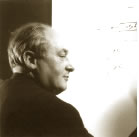Prof. Dr. Ing. e.h.
Walter Bruch
Born: 2 March 1908, Neustadt an der Weinstrasse
Died: 5 May 1990, Hanover
"There are developments that are conceivable and technically feasible. However, anybody who assumes moral, political and economic responsibility has to ask himself whether or not the developments are desirable and useful."
In 1936, Walter Bruch was a cameraman and captured the first live pictures of the Olympic Games. In 1962, he obtained a patent for PAL colour television.
Television cannon and television sets
Bruch studied electrical engineering at the technical college in Mittwaida. After taking his degree, he worked as a research associate for the TV pioneers, Manfred von Ardenne and Dénes von Mihály.
In 1935, he joined the television department of Telefunken AG. At the 1936 Berlin Summer Olympics, Bruch was cameraman and operated the so-called television cannon, a mobile iconoscope camera used for the first live transmissions.
In 1937, he received the commission to establish the first all-electronic TV studio in Germany. During World War II, he was an iconoscope expert in Peenemünde where he designed a cable TV system which allowed to observe rocket take-offs.
From 1950, Bruch was in charge of the development of the first post-war television sets at Telefunken. After thoroughly analysing the US colour TV system (NTSC) and the French SECAM system, Bruch developed the "phase alternation line" (PAL) system. In 1963, the first demonstrations of the PAL system took place.
PAL system
The PAL system (phase alternating line) uses a 4:3 aspect ratio for the transmission of colour pictures at 625 lines per frame. The picture is drawn in two passes, in the so-called half-frame process. The phase of the colour carrier of a colour difference signal is reversed by 180 degrees from line to line. The PAL system does not only transmit colour pictures but also allows the simultaneous transmission of audio channels, supporting stereo sound as well as a language choice.
The phase alternation of PAL automatically corrects colour errors. The system developed by Bruch with its very impressive degree of colour fidelity has been successful in Europe and in most countries in Asia, Africa and South America.
On 25 August 1967, German Chancellor Willy Brandt pushed the button at the IFA in Berlin to launch colour television in the Federal Republic of Germany.
Patent search
To find out more about Walter Bruch's patents, go to DEPATISnet

© gfu
Patent document DE-1252731
"Farbfernsehempfänger für ein farbgetreues NTSC-System"
(PDF - 240 KB)
"120 Years of Television"
Dipl.-Phys. Uwe Gebranzig
Barényi . Binnig . Bölkow . Bruch . Dethloff . Fischer . Hell . Lindenmeier . Oberth . v.Ohain . Peter . Quadbeck-Seeger . Ruska . Sauer . Wankel . Winnacker . Zuse
Copyright © Deutsches Patent- und Markenamt 2004
